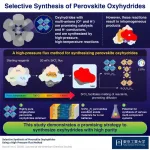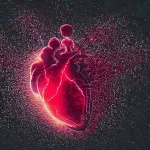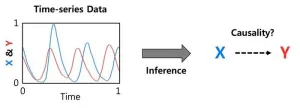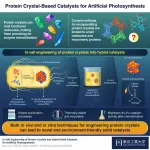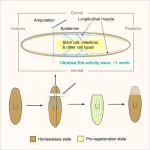(Press-News.org) A new paper in Biology Methods & Protocols, published by Oxford University Press, shows it may be possible to design vaccines that will induce a stronger immune response to infecting pathogens, such as the virus causing COVID-19. In this study, the authors proposed and tested a new bioinformatic approach and tool that allows researchers to select parts of proteins that will elicit a strong immune response. Vaccines developed based on this approach would provide better protection from diseases.
The immune system of humans (and other vertebrates) discriminates between self and non-self structures to attack and destroy the latter. T cells are the part of the immune system responsible for this recognition. They accomplish this by identifying peptides, short chains of amino acids, that are present in non-self proteins, for example, in proteins of a virus or a bacterium, but absent in proteins of a host, such as humans. To avoid recognition by a host’s T cells, parasitic organisms eliminate all unnecessary peptides from their proteins. In particular, they mutate these peptides to mimic those present in the proteins of their host species.
In this study, the researchers tested a critical prediction of peptide mimicry theory: they investigated whether they could predict the ability of a parasite’s proteins to provoke an immune response based on the content of peptides absent in their host’s bodies. Building upon earlier detailed mapping of T-cell clones related to SARS-CoV-2, they explored the intersecting points between the list of actual T-cell response targets and a list of potential T-cell recognition targets, peptides present in SARS-CoV-2 but absent in the human body.
Computer simulations showed that the actual T-cell recognition targets had a significantly higher proportion of pentapeptides and hexapeptides (peptides consisting of five and six amino acids respectively) not found in human proteins. The new method, grounded in immunological theory, was four times more efficient in detecting the targets in the case of SARS-CoV-2 than currently used methods based on empirical observations. The authors believe the method will allow researchers to develop more effective vaccines, specifically designed to recognize and target the parts of proteins of parasites that trigger the strongest immune responses.
“Our peptide mimicry theory, which delves into how a parasite adapts its peptide vocabulary to that of its host, began primarily as a fundamental research endeavor,” said the paper’s lead author, Jaroslav Flegr. “However, as we've explored this topic, we've discovered that it might also have extensive practical implications, such as in the field of vaccine construction. We hope our findings will deepen our understanding of disease evolution and pathogen transmission and provide valuable insights in the enhancement of vaccine design and the broader fight against infectious diseases.”
The paper, “Exposing and Exploiting Host-Parasite Arms Race Clues in SARS-CoV-2: A Principally New Method for Improved T-cell Immunogenicity Prediction,” is available (at midnight on July 25th ) at: https://academic.oup.com/biomethods/article-lookup/doi/10.1093/biomethods/bpad011.
Jaroslav Flegr
Professor of Biology
Charles University
140 21 Prague, CZECH REPUBLIC
flegr@cesnet.cz
To request a copy of the study, please contact:
Daniel Luzer
daniel.luzer@oup.com
END
A chance to design better vaccines?
2023-07-25
ELSE PRESS RELEASES FROM THIS DATE:
A high-pressure flux method to synthesize high-purity oxyhydrides
2023-07-25
Adding a flux during the synthesis of oxyhydrides is a promising strategy to obtain a pure, homogenous product, reveal scientists from Tokyo Tech. An SrCl2 flux promoted the melting of a part of reactants and facilitated their diffusion of reactants, which proved to be the key to producing highly pure SrVO2.4H0.6 or Sr3V2O6.2H0.8 perovskite oxyhydrides in high-pressure and high-temperature reactions. These compounds have potential as catalysts and as electrode materials for lithium-ion batteries.
Perovskite oxyhydrides ...
Multi-levitation bioprinting of heart models for space exploration and medicine
2023-07-25
As a bold venture at the forefront of biomedical research, the PULSE project is poised to develop paradigm-changing bioprinting technology for applications in space and on Earth. Awarded nearly 4 million euros by the European Innovation Council’s Pathfinder Open, PULSE emerges from interdisciplinary scientific collaborations and, over five years, will foster technological innovations to improve human health and pave the way for safer and more sustainable space exploration.
By combining magnetic and acoustic levitation into an innovative bioprinting platform, PULSE’s device should be capable of achieving unparalleled spatiotemporal control of cell deposition. ...
CHOP researchers validate pediatric “allergic march” in largest national study of its kind
2023-07-25
Philadelphia, July 25, 2023—In the largest study of its kind, researchers from Children’s Hospital of Philadelphia (CHOP) used electronic health record (EHR) data from more than 200,000 pediatric patients to describe patterns of pediatric allergies across the United States, validating a population-level pattern of allergy development known as the “allergic march,” in which allergies first present as eczema, followed by food allergies, asthma, and environmental allergies. The ...
Introducing GOBI: A breakthrough computational package for inferring causal interactions in complex systems
2023-07-25
In the quest to unravel the underlying mechanisms of natural systems, accurately identifying causal interactions is of paramount importance. Leveraging the advancements in time-series data collection through cutting-edge technologies, computational methods have emerged as powerful tools for inferring causality. However, existing model-free methods have struggled to differentiate between generalized synchrony* and causality, leading to false predictions. On the other hand, model-based methods, while accurate, have been limited by their dependence on specific models, hindering their widespread applicability.
*Synchrony ...
Towards artificial photosynthesis with engineering of protein crystals in bacteria
2023-07-25
In-cell engineering can be a powerful tool for synthesizing functional protein crystals with promising catalytic properties, show researchers at Tokyo Tech. Using genetically modified bacteria as an environmentally friendly synthesis platform, the researchers produced hybrid solid catalysts for artificial photosynthesis. These catalysts exhibit high activity, stability, and durability, highlighting the potential of the proposed innovative approach.
Protein crystals, like regular crystals, are well-ordered molecular structures with diverse properties and a huge potential for customization. They can assemble naturally from materials found within cells, which not only greatly reduces the synthesis ...
New study on sleep/circadian disturbance’s impact on multiple chronic pain disorders
2023-07-25
Can poor sleep and circadian rhythm make chronic pain conditions worse? Edson College Assistant Professor Chung Jung Mun plans to find out through an innovative longitudinal study.
Mun was awarded a $3 million grant from the National Institute of Neurological Disorders and Stroke, part of the U.S. National Institutes of Health, to explore the possible connection.
“There are countless individuals suffering from multiple chronic pain disorders. A person with chronic migraine headaches is also likely to suffer from chronic low back pain. What we’re trying to find ...
Knees up! Computational modeling could improve knee implant alignment
2023-07-25
A Texas A&M University doctoral student has collaborated with an innovative surgical navigation and robotics company on motion capture research that can potentially improve implant alignment during knee replacement surgeries.
Aaron Henry is a fourth-year Ph.D. student in the Doctor of Philosophy in Interdisciplinary Engineering program in the Department of Multidisciplinary Engineering. He worked with Caira Surgical, a surgical navigation and robotic orthopedic surgery company that focuses on simplifying workflows and developing technological ...
Regeneration might be a whole-body affair
2023-07-25
A mouse injured on one leg experiences an “awakening” of stem cells in the other leg as if the cells are preparing to heal an injury. Something similar happens in axolotls, which are masters at limb regeneration. Heart injuries in zebrafish can trigger certain changes in far-away organs like the kidney and brain.
“In many different organisms, you can see the whole body respond to an injury. But whether or not those responses actually have any function has been unclear,” says Bo Wang, assistant professor of bioengineering at Stanford, “So that’s what we’re focusing on.”
In ...
Mesoamerica a model for modern metropolises
2023-07-25
Jakarta … San Francisco … Shanghai … Phoenix … Houston.
These major cities and others around the globe have many similarities, but they share one particular commonality that is concerning for residents. They are among the global cities most affected by climate change.
While each of these cities has proven resilient for centuries, urban planners, community leaders and civil engineers continue to address their many environmental challenges. In preparing for these cities’ future, however, it might be more ...
What can central Utah’s earthquake ‘swarms’ reveal about the West’s seismicity?
2023-07-25
Most of the earthquakes rumbling under the West’s Great Basin come in surges, clustered together in time and place. Scientists call these seismic groups “swarms,” which are a distinct category from the numerous aftershocks following a big shake, such as the 5.7 magnitude Magna quake of 2020 on the Wasatch Fault.
Rather than getting spread out evenly over time, many of these small, often imperceptible quakes strike a region in a short period of time, say a few days or weeks.
Central Utah has been the stage for dozens of earthquake swarms that have been recorded over the past 40 years by an ever-expanding network of seismic arrays managed by the University ...
